Nestled within the embrace of the vast Chinese landmass, Shanxi Province is renowned for its profound history and rich cultural heritage. Beyond the Han ethnic group, which dominates the population, Shanxi is also home to numerous ethnic minorities, all ethnic groups together to write a colorful Shanxi chapter.
Hui Ethnic Group
During the late Yuan and early Ming dynasties, a large number of Hui people migrated to Shanxi due to various reasons, such as military campaigns, dispatches, migrations, and business activities, marking the formation period of the Hui community in Shanxi. During the Hongwu period of the Ming dynasty(AD 1368-1396), Zhumo, the emperor, granted feudal titles to various princes, among whom the Lu Prince(潞王) was granted the title of the feudal prince of Changzhi, which is today’s Changzhi City in Shanxi. In the sixth year of the Yongle period of the Ming dynasty (AD 1408), zhumo, the King of Shen(沈王朱模), was granted the title of the feudal prince of Changzhi. Among his escort personnel who moved to Luzhou, there were more than 100 Hui people, most of whom came from the surnames Ma and Cheng in Nanjing Shuiximen, including soldiers, craftsmen, and merchants. They settled in Tongguo, Nantou, and Yingkou, which are located around the imperial city of Changzhi, also known as the San Daoying area, becoming a significant concentration area for the Hui people in Shanxi.
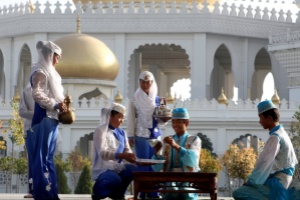
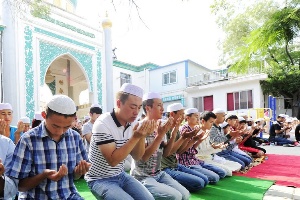
The culture of the Hui ethnic group is deeply influenced by Islam and has a strong religious color. Among them, offering prayers is an indispensable part of their daily life. Prayer is an activity in which the Hui people practice their faith through tangible worship activities, expressing their faith through these activities. It is a faith activity that combines knowledge and practice.
The culture of the Hui ethnic group is also reflected in their clothing, diet, and etiquette. Male traditional clothing consists of a white robe and a white or black cap. Females wear black or blue robes and black or red caps. The dietary culture of the Hui ethnic group mainly consists of mutton, beef, and other meat-based foods, with representative dishes such as mutton kebabs, hand-grabbed rice, and whole-roasted sheep. In terms of etiquette, the Hui people attach great importance to traditional virtues such as respecting the elderly and caring for the young, respecting women, and emphasizing hygiene. They are thoughtful and enthusiastic on social occasions.
Manchu
The majority of the Manchu people in Shanxi migrated to this region during the Qing dynasty. During the Qing period, as the ruling ethnic group, the Manchu population was scattered throughout the country. Some Manchu officials, soldiers, and immigrants came to Shanxi for various reasons, gradually forming today's Manchu community.
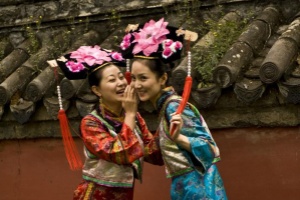
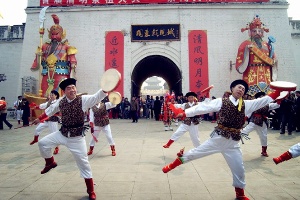
The Manchu culture possesses unique styles and characteristics, encompassing language, script, clothing, music, dance, and other aspects. The Manchu people have their language, known as "Manchu". They also have their writing system, referred to as "Manchu script". Created at the end of the 16th century, Manchu script is a new form of writing that uses Mongolian letters to spell out the pronunciation of Manchu words.
The traditional costumes of the Manchu people exhibit unique styles and characteristics. Men often wear long robes and mandarin jackets, while women dress in wide-sleeved robes and waist-cinching skirts. The Manchu also have some unique festivals and customs. For example, the “Banjing Festival” is an important occasion for the Manchu people to commemorate their ancestors, and they hold grand celebrations, including ancestor worship, dining together, and dance and music performances. Additionally, some Manchu families follow traditional Manchu dietary habits, preferring sticky foods, sour and spicy dishes, and other delicacies.
Mongolian Ethnic Group
As early as the Spring and Autumn and Warring States periods, there were a large number of Mongolians residing in the Shanxi region. Starting from the Tang dynasty, the Mongolians gradually migrated to Shanxi on a large scale, forming long-term interactions and integrations with the Han Chinese. The establishment of the Yuan dynasty further promoted the migration and integration of the Mongolians in Shanxi, as large numbers of Mongolians migrated to the region and mixed with the Han Chinese, forming a unique integrated culture. During the Ming and Qing dynasties, the Mongolian people of Shanxi played important roles in historical changes. They not only served as border generals to maintain border tranquility but also had a profound impact on the economy and culture of Shanxi.
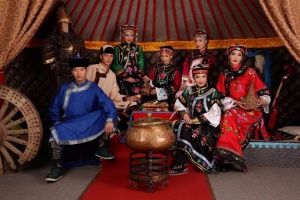
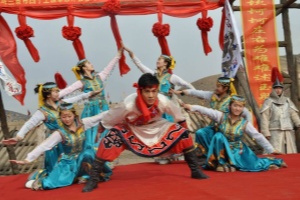
The Mongolian people in Shanxi possess some unique customs and traditions. For instance, the Five Domestic Animals culture of the Mongolians is an essential component of their traditional culture. The Five Domestic Animals refer to goats, sheep, cows, horses, and camels, all of which play significant roles in the lives of the Mongolian people. Goats and sheep are the primary sources of food for the Mongolians, while horses serve as their means of transportation and hunting tools. Furthermore, the Mongolian horse culture is also unique, as the horse in the Mongolian language symbolizes might, spirit, and luck. The worship and respect for horses among the Mongolian people are reflected in their daily lives.
The Mongolian people in Shanxi maintain unique traditions in cultural inheritance. Their language incorporates a significant amount of Mongolian language elements, such as vocabulary in Xinzhou dialect that exhibits distinct Mongolian language characteristics. Mongolian clothing has a strong ethnic identity, with Mongolian boots divided into two types: horse boots and Mongolian boots. The robes are wide with long sleeves, and brightly colored, and the belt is an essential accessory when wearing Mongolian robes. These costumes not only serve as traditional attire for the Mongolian people but also symbolize their cultural identity.
Yi Ethnic Group
According to historical records and archaeological research, the formation process of the Yi people is diverse and complex, with its origins tracing back to the ancient Qiang people. These Qiang people resided in the Hehuang region of northwest China approximately 6,000 to 7,000 years ago and gradually divided and migrated outward. During the Han Dynasty, the ancestral Yi people’s activity center was located around Dianchi Lake and Qiongdu (southeast of Xichang, Sichuan, today). As history progressed, the ancestral Yi people gradually migrated to the southwest region and established multiple tribal regimes, such as the ancient Mang State. During this period, the Yi people's culture and social structure took shape.
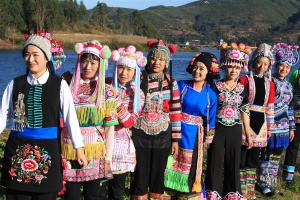
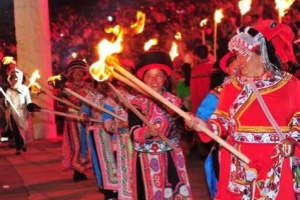
The Yi people believe in primitive religions and worship nature, spirits, ghosts, ancestors, and other deities. They venerate natural gods such as mountain gods and water gods, believing that these gods possess supernatural powers that can bless them with peace, abundance, and happiness. Additionally, the Yi people also worship certain animals, such as tigers and dragons, believing that these animals carry special symbolic meanings.
The Yi people also preserve some traditional festivals and customs. For example, the Torch Festival is one of the most solemn traditional festivals of the Yi people. During this festival, they will light torches at night, sing and dance around the bonfire, praying for a bountiful harvest and happiness.
Miao Ethnic Group
The ancestors of the Miao people can be traced back to the ancient Chi You(蚩尤) tribe of China. Chi You, honored as the “Lord of War”, is considered the ancestor of the Miao and other southern ethnic groups, and is known alongside Huang Di and Yan Di as one of the Three Ancestors of China. Throughout history, the Miao people have experienced numerous migrations. Among these, forced migrations due to defeats in battle are significant events in Miao history. Following these defeats, some Miao groups migrated southward and westward, settling primarily in the southwestern mountain regions and the Yunnan-Guizhou Plateau. During this process, the Miao people integrated with local indigenous groups, developing unique cultural and traditional practices.
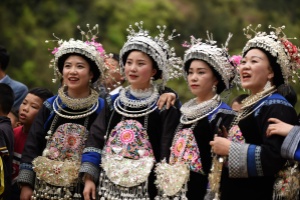
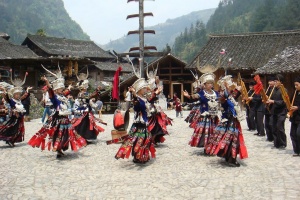
The Miao people in Shanxi have maintained unique traditions in cultural inheritance. Their costumes are primarily handmade with bright colors and diverse patterns, rich in ethnic charm. The music and dance of the Miao people also exhibit unique ethnic characteristics, such as lantern dance, wooden board dance, and grass shoe dance. These musical and dance forms not only reflect the life and emotions of the Miao people but are also essential components of Miao culture.
The Miao people in Shanxi possess some unique customs and traditions. For instance, they believe in polytheism, venerating both nature and ancestral spirits. The Miao people hold a special cult and belief towards natural objects, such as boulders, caves, and trees, believing that these objects possess spiritual powers that can bring good luck and well-being. In terms of festivals, the Miao people celebrate a diverse array of traditional holidays, such as the Huashan Festival, the Dragon Boat Festival, and the Miao New Year. These festivals not only reflect the rich cultural life of the Miao people but also serve as important vehicles for the inheritance and promotion of Miao culture.
Tujia Ethnic Group
The Tujia people are a nation with a long history, whose ancestors can be traced back to the ancient “Man” or “Yi” tribes. Before the Song Dynasty, the Tujia people residing in the Wuling region, along with other ethnic minorities, were collectively referred to as “Wuling Man” or “Wuxi Man”. However, Shanxi is not the primary concentration area for the Tujia people.
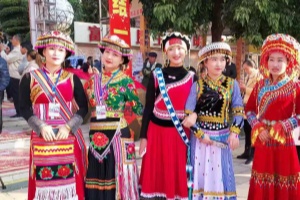
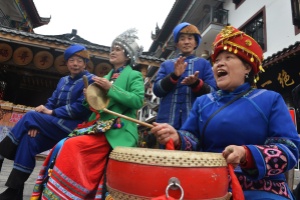
The Tujia people in Shanxi maintain unique traditions in cultural inheritance. Their clothing primarily consists of blue and white hues. Male attire typically features a short, buttoned jacket, trousers, and a headwrap. Female attire consists of a long-sleeved dress with a right-side lapel, a long skirt, and a headwrap. These patterns on their clothing symbolize good luck, happiness, and fulfillment. Additionally, the Tujia people excel in agriculture and animal husbandry, with rice and corn being their staple foods. They are also skilled in preparing foods such as Mantou, and noodles. Tea culture is also significant among the Tujia, as they enjoy drinking strong tea, believing it aids in digestion, reduces greasiness, and enhances alertness. In terms of festive customs, the Tujia people have many unique holidays, such as the Niuwang festival, and the Dragon Boat festival. These festivals are not only significant moments for the Tujia people to celebrate their harvests and pray for peace but also important vehicles for the inheritance and promotion of their ethnic culture.




































